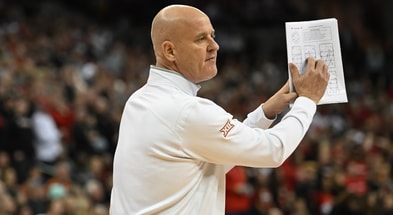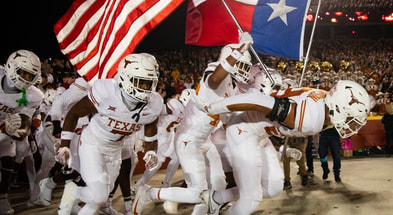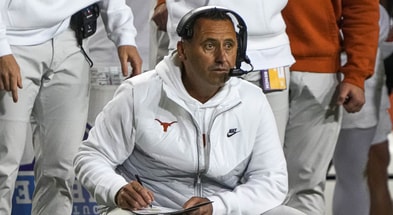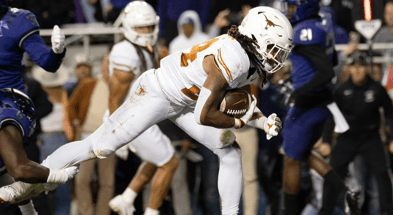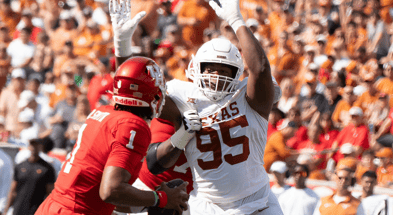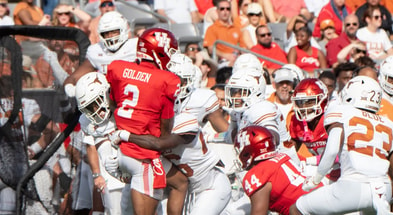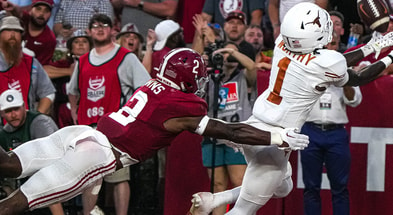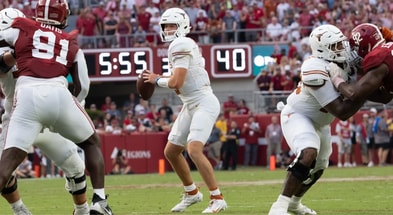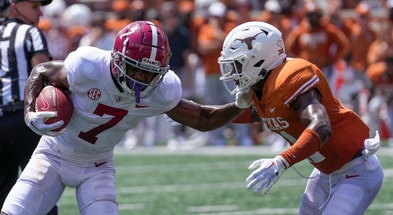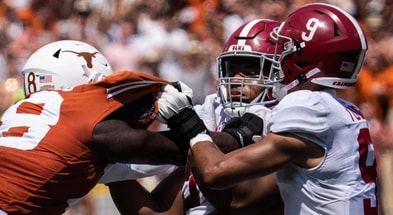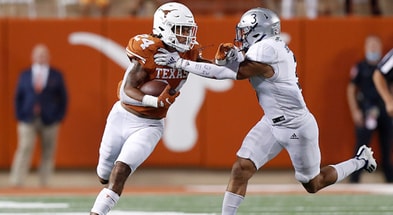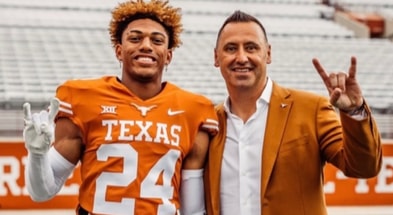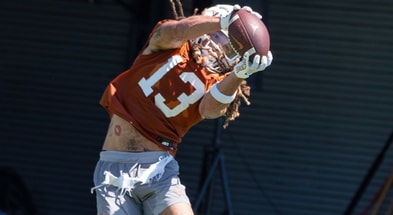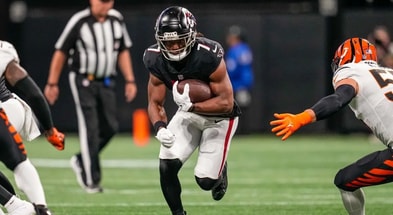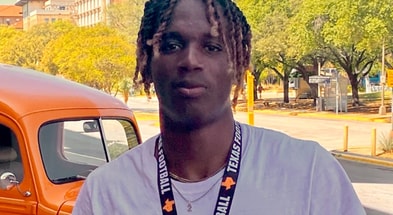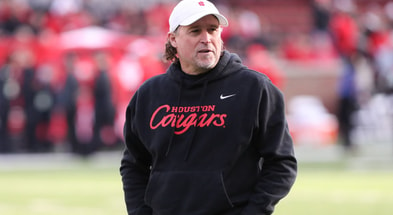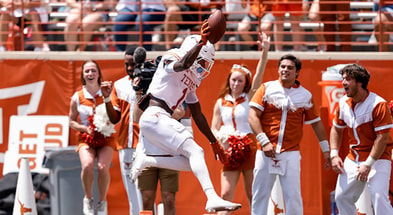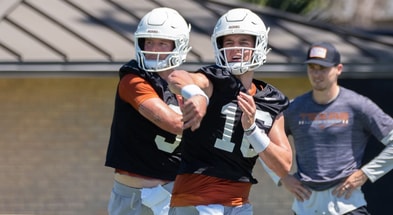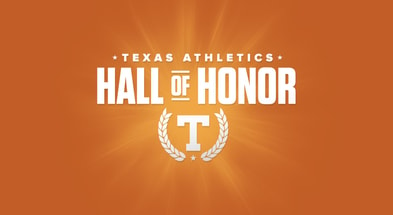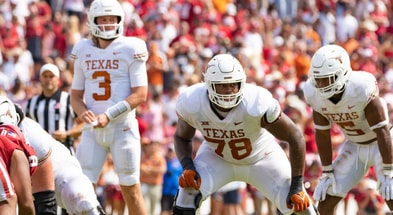4 remaining questions for Texas football after fall camp
Fall camp is now over. Texas football has its two-deep, including the starting quarterback, and is in the middle of preparations for playing Billy Napier’s Louisiana Ragin’ Cajuns. We’ll have more on the Fighting Napiers later in the week, suffice to say for now they are a good football team which is clearly well coached but MOSTLY lacking high-end talent. Rosters with 20 returning starters who’ve been in the program four, five, or six years typically aren’t loaded with NFL players.
We’ve learned a fair amount about the Longhorns’ own roster, which has far fewer returning starters in some of the key positions across the team. A few questions remain.
How ready is Hudson Card?
For essentially the entirety of the Steve Sarkisian era to date, the main talking point regarding Texas’ quarterback situation is the classic refrain you hear when a coach is overseeing a battle for the starting job. “We can win with both guys!”
In reality, fielding a single quarterback who’s a strong leader and playmaker isn’t very easy. For most of the 2010s, Texas was hoping to have even one such player on campus and healthy. Most of the time, although not always, when a coach says “we can win with both guys” it really means either the competition isn’t actually close or neither is particularly good, not that both guys are dueling for the chance to be all-conference.
This battle has always contained the tricky dynamic of Casey Thompson’s poor fit within Sark’s offense. Thompson was a good prospect for the Tom Herman offense, which was designed to use the quarterback as a point guard distributing the ball to the perimeter or inside to the running back in the inside zone run game and then bring value-add as a featured runner or as a scrambler in the passing game. It’s very easy to imagine Thompson having success in an offense like the one Greg Ward Jr. operated at Houston.
Sark’s offense is different. The quarterback’s ability to scramble, much less be a feature back on third and two, is de-emphasized. If the quarterback is running around in the backfield, Sark would prefer it’s to check down or throw it away.
The “point guard” distribution in the inside run game is also considerably more involved, with full-field RPO reads, option routes on the perimeter, and heavy doses of play-action. Thompson clearly has some throwing ability on one-read throws but was always going to be more comfortable in a system which allowed him to throw outside and on the move rather than navigating interior defenders (like Luke Brockermeyer). “Throw it or run it yourself” is more the type of RPO where Thompson could thrive, not the more skill-intensive, “if you see X coverage, go through this progression, otherwise hand off” system Sark teaches.
So Card, the more fluid and versatile passer, was always a much cleaner fit, but he still had to beat out the older quarterback. He’s now done so, pending in-game performances which dramatically change the dynamics of the competition.
The big remaining question is the extent to which Card’s ascendance to QB1 is a function of his preparedness and to what extent the decision was made by Thompson’s poor fit and inability to avoid interceptions. Louisiana should help sort this question out.
Can Texas control the box?
Both Sark and his defensive coordinator Pete Kwiatkowski each have systems designed to help them control the box with six primary players. Napier’s Louisiana team has a similar design, albeit with different schemes, so who’s going to win at the point of attack? Whether or not Texas can impose their will in the trenches will be put to the test immediately.
The reports on the Texas defense sound very promising. The expectation is for Texas to be able to send waves of highly talented defensive tackles at opponents, even to the point of struggling to maximize all the talent which deserves to be on the field. Linebacker appears solidified by the growth from Luke Brockermeyer and David Gbenda combined with the return of DeMarvion Overshown. It’d be surprising if the Texas defensive front struggled with any regularity in the fall.
On offense, the picture is less clear. The interior group of Denzel Okafor, Jacob Majors, and Junior Angilau was expected to be a team strength until they had to face the Longhorn defensive front all offseason and rarely seem to get the better of them in reports. Jared Wiley’s blocking as a tight end is not yet established as a team strength either and there’s both good and bad from his spring game performance.
The Texas front was plenty effective in 2019 with Angilau and Kerstetter prominently involved and Majors, Okafor, and Jones were dominant against K-State and Colorado late in 2020. The spectrum of “great against bad competition yet unable to dominate great competition” is pretty massive. Where along the spectrum does the offensive front fall?
How will teams attack this defense?
I think there may be some trial and error from Texas’ opponents this season in sorting out how to get the best of Pete Kwiatkowski and this defensive personnel. Had I not been closely following our insider reports all offseason, my first instinct would have been to expect Texas vulnerability in the middle of the field.
If you double the tackles can the linebackers find the ball? How will they fare when hunted in coverage?
But now I suspect the answers to those questions is not only positive, but potentially very positive. I expect Brockermeyer and Overshown to be problems in coverage and playmakers in the run game as a result of playing behind Coburn, Moro Ojomo, and the others.
So how will teams get after the Longhorns?
If you want to attack the safeties, it’s going to be difficult in this scheme which plays three cornerbacks at a time, even in base defense (if Anthony Cook plays free safety). Check out the matchups for a team trying to attack Texas’ 3-4 package with a double tight end formation.
When the free safety is Anthony Cook, you can still drop him down over a slot like you would in nickel and free up the Sam linebacker to play on the edge and across from a tight end. Overall the safeties in PK’s defense are very much a support position, showing up as needed from a safe depth, they’re not going to be asked to play primary roles at the point of attack like in previous schemes.
Beating Texas’ nickel and cornerbacks in coverage may work but it doesn’t really seem like an efficient strategy to throw against them regularly for teams who don’t have really high level passing attacks and great receivers.
This leaves the edges as the place to attack. How will the Jacks and Bucks (outside linebacker ends) handle teams coming downhill at them with good blocking tight ends and tackles? Will Texas’ speedy linebackers look fast if opponents can get push off tackle?
It’s very probable there are no glaring weak spots in the Texas defense unless you have higher caliber players on offense. This is a huge boost in the Big 12 where many coordinators know how to pick at a weak spot and force you to overcompensate. Texas may only need to compensate for opposing strengths rather than personal weaknesses.
Who’s the leading receiver in 2021?
The smart money here is on one of Tom Herman’s two more talented holdovers, Joshua Moore and Jordan Whittington. As you’d expect from upperclassmen with actual experience, those two been among the more consistent performers in fall camp. Both of them are Herman-style slots, with elite quickness (3.96 shuttle for Moore, 4.07 shuttle for J-Whitt) but missing the extra gear going down the field (4.67 40 for Moore, 4.68 40 for J-Whitt).
While the lack of top end speed isn’t ideal for the play-action game, both Moore and J-Whitt are good fits for RPOs, especially if they’ve improved their releases off the line of scrimmage and Sark can scheme Joshua Moore away from good press coverage (using an inline tight end will help). Whitt has the strength and skill now to win inside on the glance routes Sark loves so much while Moore was already lethal there provided he couldn’t get jammed up. Moore will probably also be the main deep threat option in the offense, although Xavier Worthy and perhaps Kelvontay Dixon may have some input here before the end of the season.
Texas badly needs reliable RPO targets on the perimeter, both to play to Hudson Card’s strengths and also to maximize spacing in the box for Bijan Robinson. A terrifying deep threat would take this team up another level and give them a potential ceiling as a Big 12 Champion, but at the very least they could have a good year simply by fielding a guy or two who can deal some damage to teams like Louisiana.
Texas will be able to take an initial stab at providing meaningful answers to all of these questions against Louisiana on Saturday. This team will likely improve over the course of the season, but good early results could portend a big year one for Sark.
Cover photo by Will Gallagher for Inside Texas
